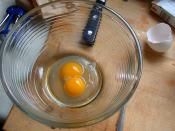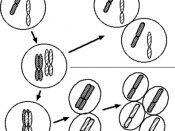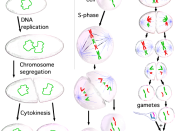Organisms can reproduce by two processes, asexual and sexual reproduction. Asexual reproduction is the production of offspring by a single parent. Offspring produced asexually inherit their DNA from only one parent and are genetically identical to that parent. Reproductive processes that involve obtaining genetic information from two parents that involve the union of a sperm and an egg is called sexual reproduction. A sperm and egg individually carry one set of genetic information. Egg and sperm cells are collectively known as gametes. Gametes are formed by a kind of cell division called mitosis.
The fusion of a sperm from the father and the egg cells from the mother is known as fertilization. The resulting fertilized egg is called a zygote, and is diploid. The zygote consists of two haploid sets of chromosomes, one from the mother and one from the father.
In the meiotic process of cell division the number of chromosomes in a cell reduces from diploid to haploid.
Meiosis consists of two consecutive stages of cell division, called meiosis I and meiosis II. As a result of meiosis four daughter cells (gametes) are produced with only half as many chromosomes as the starting cell. Each gamete has one member of each homologous chromosome pair.
There are eight stages of meiosis. Four of stages are in meiosis I, the phase of the division where the homologous chromosomes separate. A homologous chromosome is two chromosomes that make up a matched pair in a diploid cell. They are the same length, have the same centromere position, and staining pattern and possess genes for the same characteristics. Like mitosis, the stages of meiosis I are preceded by an interphase where the number of chromosome replicate. Prophase I of meiosis is the most complex phase and takes up 90% of the time...


